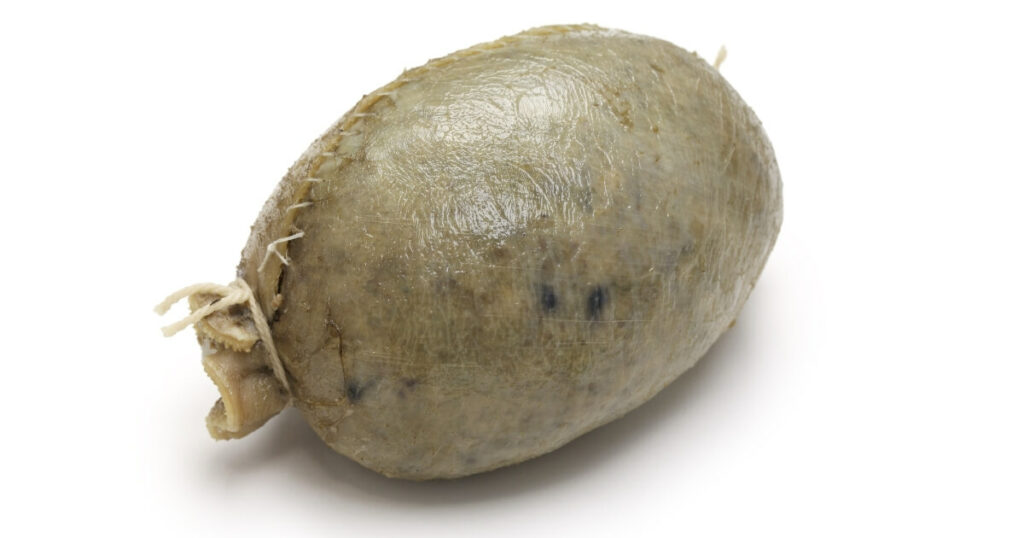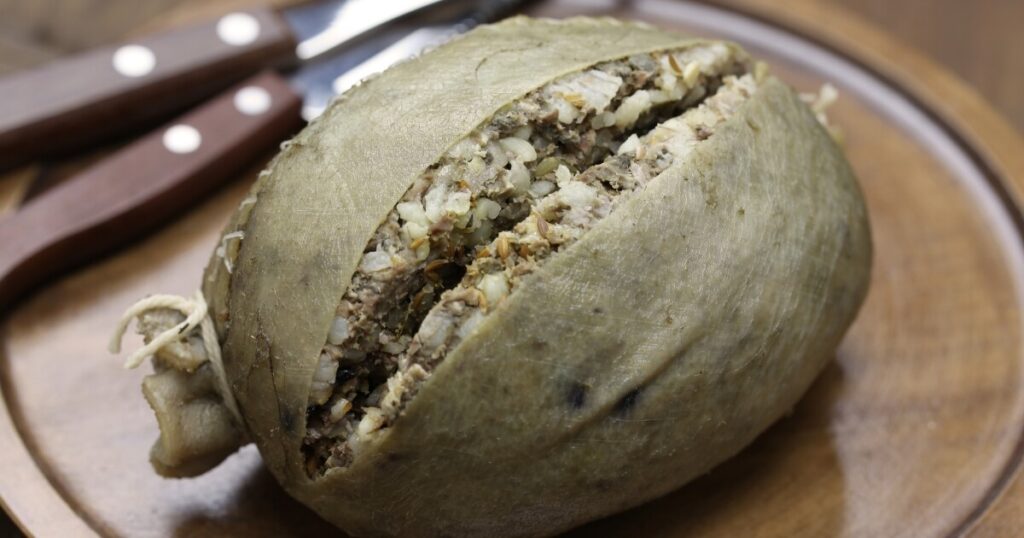You might have heard of it, but do you really know what Haggis tastes like?
As a home cook who loves exploring different flavors, I’ve had the pleasure of experiencing this traditional dish, and I’m excited to share my insights with you.
Haggis, a staple of Scottish cuisine, is a dish that sparks curiosity and sometimes a bit of apprehension. Imagine a rich, hearty dish with a beautiful blend of spices that gives it a distinct, peppery kick. Intrigued yet?
In this article, we’ll discuss its robust, meaty flavor to its, grainy texture, how it compares to similar foods, and how to make it taste the best it can be.
So, let me take you on a journey to the heart of Scotland, home of the legendary Haggis.
How Does Haggis Taste?
The taste of Haggis is a delightful symphony of flavors. It’s rich, hearty, and peppery with a full-bodied spice profile. Its texture is grainy yet tender, like a crumbly sausage, offering a unique mouthfeel.

Diving deeper into the taste of Haggis, you’ll find it has a robust, meaty, earthy, filling flavor.
The key ingredients of sheep’s heart, liver, and lungs are minced with onion, oatmeal, suet, and spices, creating a complex, unique flavor profile.

The oatmeal lends a comforting, grainy texture, while the organ meats provide a depth of flavor that’s rich and satisfying.
The aroma of Haggis is as enticing as its taste. A warm, aromatic scent fills the kitchen the moment it starts cooking, hinting at the hearty meal to come.
The taste of Haggis can vary slightly depending on the specific recipe used. Some versions might be more peppery, while others might have a stronger aroma of onions or a more pronounced organ meat flavor.
But no matter the variation, the essence of Haggis, its hearty, rich, and robust character, always shines through.
What Does Haggis Compare With?
- Liver and Onions: The organ meat in Haggis gives it a flavor profile similar to dishes like liver and onions. Both have a rich, meaty taste that’s hearty and satisfying.
- Dense Meatloaf: The texture of Haggis, with its grainy yet tender consistency, can be compared to a dense, well-cooked meatloaf.
- Black Pudding: Another traditional dish, black pudding, shares a similar spice profile with Haggis. Both have a peppery kick that adds depth to their flavors.
- Crumbly Sausage: The way haggis crumbles when cut open is reminiscent of certain types of well-cooked sausage.
- Spiced Mince: The combination of minced meat and spices in Haggis is similar to spiced mince dishes, offering a full-bodied, robust flavor.
Does Haggis Taste Good?
If you’re not accustomed to organ meats or dishes with a strong, meaty flavor, Haggis might be a bit of a challenge.
The distinct taste of the organ meats used in Haggis is something that might take some getting used to.
Additionally, while adding depth to the dish, the peppery spice profile might be a bit overwhelming for those who prefer milder flavors.
Another aspect to consider is the preparation method of Haggis. It’s traditionally encased in a sheep’s stomach, which might be off-putting for some.
However, most commercial Haggis today is prepared in a synthetic casing, making it more accessible to a wider audience.
How To Make Haggis Taste Good
- Pair it with the right sides: Traditionally, Haggis is served with ‘neeps and tatties’ (mashed turnip and potatoes). The sweetness of these sides complements Haggis’s rich, hearty flavor beautifully.
- Use quality ingredients: As with any dish, the quality of ingredients can greatly affect the final taste. Use fresh organ meats, good-quality oatmeal, and spices for the best flavor.
- Don’t skimp on the spices: The spices are what give Haggis its distinctive flavor. Don’t be shy with the black pepper, nutmeg, and coriander.
- Cook it slowly: Haggis needs to be simmered slowly to allow the flavors to meld together and the texture to become tender.
- Try it with a sauce: A whisky sauce is a traditional accompaniment to Haggis and can enhance its flavor. The sauce’s richness and slight sweetness can balance the robust flavor of the Haggis.
- Experiment with modern versions: If traditional Haggis isn’t to your liking, modern versions are available that substitute the organ meats with other ingredients like lentils and vegetables, offering a different, yet still delicious, taste experience.
How To Eat Haggis
Traditional Method
The most traditional way to enjoy Haggis is as the centerpiece of a Burns supper, an event held annually on January 25th to celebrate the life of Scottish poet Robert Burns.
The Haggis is typically served with ‘neeps and tatties’ (mashed turnip and potatoes) and a dram (glass) of Scotch whisky.
Haggis, Neeps, and Tatties Stack

A popular modern presentation of Haggis is to serve it as a ‘stack’ with neeps and tatties.
Each component is shaped into a round, and then they are stacked on top of each other, usually with the Haggis on the bottom, the neeps in the middle, and the tatties on top.
This creates a visually appealing dish that’s also delicious.
Haggis in Scottish Breakfast

Haggis can also be included as part of a full Scottish breakfast. It’s served alongside other breakfast items like eggs, bacon, black pudding, and toast.
The robust flavor of haggis pairs well with the other components, adding a unique twist to the breakfast spread.
Haggis-Stuffed Chicken
For a creative twist, try stuffing a chicken breast with Haggis. The chicken provides a mild counterpoint to the rich, spicy Haggis, and the two textures complement each other well.
Vegetarian Haggis
For vegetarians, there are versions of Haggis that substitute organ meats with lentils, mushrooms, and other vegetables.
This vegetarian Haggis retains the spicy, hearty flavor of the traditional version, making it a great option for those who don’t eat meat. It can be served in the same ways as regular Haggis.
What Does Haggis Look Like?
In its raw form, Haggis is encased in a casing, traditionally a sheep’s stomach, but more commonly a synthetic casing in modern versions.

It resembles a large, round sausage or a small, plump pillow. The casing is filled with a mixture of minced sheep’s heart, liver, and lungs, along with oatmeal, suet, and spices.
The color of raw Haggis is generally pale and off-white due to the oatmeal and suet, with specks of darker colors from the organ meats and spices. The texture is crumbly, grainy, yet firm, as the casing holds everything together.
Once cooked, Haggis turns a rich, dark brown color. The casing becomes tighter and firmer as the contents inside expand with the heat.

When cut open, the crumbly, grainy texture is more evident, and the aroma of the cooked organ meats and spices is quite pronounced.
The appearance of Haggis might be a bit unusual to those unfamiliar with it, but it’s a testament to its unique character. It’s a dish that carries the tradition and heartiness of Scottish cuisine.
Haggis FAQs
What are the main ingredients in Haggis?
Haggis is made from a mixture of sheep’s heart, liver, and lungs. It’s minced with onion, oatmeal, suet, and spices. This mixture is then encased in the animal’s stomach, though synthetic casings are often used in modern versions.
Is Haggis safe to eat?
Absolutely, Haggis is safe to eat. Like any other meat product, it should be cooked thoroughly before consumption. The organ meats used in Haggis are rich in nutrients, and oatmeal provides a good source of fiber. However, as with any food, if you have specific dietary restrictions or allergies, it’s always a good idea to check the ingredients before eating.
Can you buy Haggis in the US?
The sale of traditional Haggis has been banned in the US since 1971 due to the country’s food safety regulations, which prohibit the use of sheep’s lungs in food products. However, modified versions of Haggis that comply with US regulations are available. These versions typically substitute the sheep’s lung with other ingredients but aim to maintain the traditional flavor of Haggis. You can find these versions in specialty food stores or online.
My Tasty Thoughts
Yes, the ingredients might sound unusual, and the preparation method might seem a bit daunting, but the result is a dish full of flavor and tradition.
And remember, the beauty of cooking is in the journey as much as the destination. So, whether you’re making Haggis from scratch or trying it at a restaurant, embrace the experience.
Savor the flavors, enjoy the textures, and most importantly, have fun with it. After all, every dish has a story to tell, and Haggis has a tale that’s as rich and hearty as its taste.


